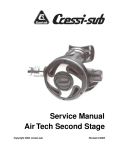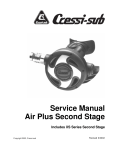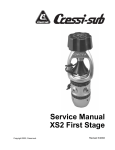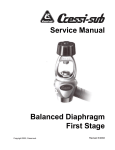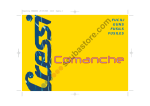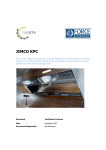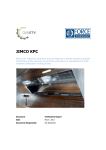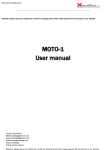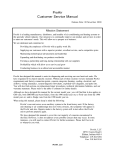Download BalancedPistonFirstStage537 KBytes
Transcript
Service Manual Balanced Piston First Stage Copyright 2002, Cressi-sub Revised 3/2002 ○ ○ ○ ○ ○ ○ ○ 2 Balanced Piston First Stage Service Manual Contents BEFORE STARTING ....................................................................................... 3 DISASSEMBLY ................................................................................................ 3 PARTS CLEANING AND LUBRICATION ....................................................... 5 CLEANING METAL PARTS ............................................................................................ 5 CLEANING COMBINATION METAL/PLASTIC PARTS .................................................. 5 CLEANING PLASTIC-ONLY PARTS .............................................................................. 6 LUBRICATION ................................................................................................................ 6 Types of Lubricant ..................................................................................................... 6 O-rings ....................................................................................................................... 6 Threaded parts .......................................................................................................... 6 Adjustment pins ......................................................................................................... 6 REASSEMBLY ................................................................................................. 7 ADJUSTMENT PROCEDURE ......................................................................... 8 FINAL ASSEMBLY AND TESTING ................................................................. 9 Tool Description ........................................................................................................... .................................................................................................................................... Used for ................................................................................................................... 10 TABLE 1 - TROUBLESHOOTING ................................................................. 10 TABLE 2 - REQUIRED TOOLS ..................................................................... 10 EXPLODED PARTS DIAGRAM..................................................................... 11 ○ ○ ○ ○ ○ ○ ○ BEFORE STARTING WARNING This manual is not a training document. It is meant to be a guide for experienced technicians who have also received factory training at a Cressi-sanctioned repair seminar. Do not attempt to repair this or any regulator without the proper training. Before starting, Cressi recommends that you read through the entire manual to familiarize yourself with all the required tools and techniques. Use this manual as a guide during the servicing process to avoid missing any critical steps. Make sure the work area is clean and that you work over a cushioned work surface so critical parts do not get damaged. Pay close attention to all warnings and cautions as they will alert you to any potential hazard that may cause damage or injury. Also, pay attention to the notes as they provide important tips and reminders. DISASSEMBLY 1. Remove any hoses attached to the first stage using the appropriate sized wrench. (Note: Hose servicing is covered in the Airtech and Airplus Second Stage Repair Manual). 2. Using a 4mm hex wrench, remove the remaining port plugs (2 & 16). Remove and discard the O-ring (3 & 17) on each port plug. 3. Unscrew the yoke knob (26) 4. Unweave the dust cap (32) from the yoke. Using an O-ring tool, remove the O-ring located in the face of the dust cap (if equipped). CAUTION The following steps require that the first stage be secured in a vise. Never secure the first stage directly in the vise as it will damage the body. Instead, thread a vise-mounting tool into the HP port (marked 300 bar/4000 psi), and tighten the mounting tool in the vise. Vise mounting tools are available from third party accessory companies, or you can use the following homemade tool: Thread a high-pressure adapter (3/8” female to 7/16” male) onto an expired CO2 cartridge. Screw the cartridge into the HP port on the first stage. Mount the CO2 cartridge in the vise. DO NOT thread the CO2 cartridge without the adapter into a LP port. If the threads of the CO2 cartridge break off, it will ruin the first-stage body. 3 ○ ○ ○ ○ ○ ○ ○ 4 Balanced Piston First Stage Service Manual 5. 6. 7. Mount the first stage into a vise as described in the caution above. Using a large adjustable wrench or 1-inch crows-foot, unscrew the inlet fitting (28) as shown in figure 1. Separate the inlet fitting from the yoke (25) and spacer (24). Leave the first stage mounted in the vise. Using a pair of needlenose pliers, squeeze the two “legs” of the filter-retaining clip (31) together and remove the clip (see figure 2). Turn the inlet fitting over and let the filter (30) drop out into your hand. Remove the inside O-ring (29), located underneath where the filter was, and remove the outer O-ring (27) located above the threads. Figure 1. Remove the inlet fitting Figure 2. Remove the filter retaining clip Using a side spanner wrench, remove the piston chamber (6) by hooking the wrench into one of the holes and turning the chamber counterclockwise (see figure 3). Figure 3. Remove piston chamber ○ ○ ○ ○ ○ ○ ○ 8. Carefully remove the piston (10) from the piston chamber (see figure 4). Take special care not to drop the piston as it may damage the end that seals against the HP seat. Remove the O-ring (9) located on the piston head. Figure 4. Remove piston from chamber 10. Lift out the main spring (11). Remove the first stage body from the vise (but leave the mounting tool in place). Tap the first stage against the workbench until the spring support (12) falls out (see figure 5). Figure 5. Remove spring support 11. Using a thin, wide-bladed tool (a common butterknife works well), unscrew the retaining ring (13) as shown in figure 6. Using an O-ring tool, carefully lift out the washer (14) and O-ring (15) as shown in figure 7. Figure 6. Remove retainer Figure 7. Remove back-up ring and O-ring 5 ○ ○ ○ ○ ○ ○ ○ 6 Balanced Piston First Stage Service Manual 12. Loosen the vise and turn the first stage body so the adjustment screw (22) is facing upward. Using a 6mm hex wrench, remove the adjustment screw as shown in figure 8. Remove the rubber cap (23) as shown in figure 9. Figure 8. Remove adjustment screw Figure 9. Remove rubber cap 13. Using a 6mm hex wrench, unscrew the high pressure plug (21) as shown in figure 10. Figure 10. Remove HP plug WARNING When blowing out the high pressure seat with an air nozzle, hold the plug just above the workbench with the seat facing down. Make sure the seat cannot fly out of the plug, causing injury. 14. The high pressure seat (20) fits tightly in the high pressure plug, therefore, it should be removed with a quick blast of pressurized air. To do this, insert a pressurized air nozzle into the hex hole of the high pressure plug. Slowly introduce air into the hex hole to push the HP seat out of the plug (see figure 11). Figure 11. Blow HP seat with air nozzle ○ ○ ○ ○ ○ ○ ○ 15. Remove the O-ring (19) located inside the body (see figure 12). Figure 12. Blow HP O-ring 16. Remove the three IP adjustment pins (18) by pushing the pins flush to one side of the body and grasping the exposed end with needlenose pliers (see figure 13). Figure 13. Remove adjustment pins 17. Thread a 3/8” inch vise mounting tool into one of the LP swivel ports. Mount the swivel into a vise with piston chamber facing upward. Using an 6mm hex wrench, remove the swivel retaining nut (8) as shown in figure 14. Using an O-ring tool, lift out the washer (7) as shown in figure 15. Figure 14. Remove swivel retainer Figure 15. Remove swivel washer 7 ○ ○ ○ ○ ○ ○ ○ 8 Balanced Piston First Stage Service Manual 18. Separate the swivel (1) from the piston chamber (6) and remove the spacer ring (5) as shown in figure 16. Remove the swivel O-ring (4). Figure 16. Separate swivel from piston chamber and remove spacer THIS ENDS DISASSEMBLY PARTS CLEANING AND LUBRICATION CLEANING METAL PARTS CAUTION Keep the piston separate from the other parts while cleaning. If the end of the piston is damaged, it will not be able to seal against the HP seat and the piston will have to be replaced. 1. Wash all the metal parts in a hot, soapy water solution. Use a soft bristle toothbrush to clean the threads and remove any flaky corrosion. 2. After washing in the hot, soapy water, rinse all the parts in fresh water. 3. Place the metal parts in an ultrasonic cleaner with an appropriate cleaning solution. Avoid using harsh acids such as muriatic acid in ultrasonic cleaners. Clean the parts for 5 to 15 minutes, depending on the amount of corrosion. 4. Remove the parts from the ultrasonic cleaner and rinse them in fresh water. Blow-dry the parts using low-pressure filtered air. ○ ○ ○ ○ ○ ○ ○ CLEANING COMBINATION METAL/PLASTIC PARTS Some parts have plastic and metal molded together, such as the yoke screw (26). In general, avoid cleaning these parts in an ultrasonic cleaner with an acidic cleaning solution. Doing so may chemically attack the plastic. The yoke screw threads may be held in the ultrasonic cleaner, but do not submerge the plastic yoke knob. 1. Wash the parts in a hot, soapy water solution. Use a soft bristle toothbrush to clean the threads and remove any flaky corrosion. 2. After washing in the hot, soapy water, rinse all the parts in fresh water. 3. Blow-dry the parts using low-pressure filtered air. CLEANING PLASTIC-ONLY PARTS Avoid placing plastic parts in an ultrasonic cleaner with an acidic cleaning solution. To properly clean plastic parts, perform the same steps listed above. LUBRICATION Types of Lubricant Cressi recommends using only food-grade silicone grease or, more preferably, Christo-lube MCG 111. CAUTION DO NOT use spray silicones as the aerosol propellants may chemically attack the rubber compound. O-rings All O-rings should be treated with a thin film of lubrication. Do not over-lubricate the O-rings with large amounts of grease. Simply place a small amount of grease between your thumb and forefinger and run the O-ring between them. Threaded parts You may lightly lubricate first two threads. As you tighten parts together, the lubricant will spread to the other threads. Adjustment pins Lubricate the three adjustment pins (18) with a light film of grease. 9 ○ ○ ○ ○ ○ ○ ○ 10 Balanced Piston First Stage Service Manual REASSEMBLY 1. Install a new, lubricated O-ring (4) onto the swivel (1) as shown in figure 17. Place the spacer ring (5) onto the tapered side of the piston chamber (6) as shown in figure 18. Press the swivel (1) into the piston chamber. Place the washer (7) into the bottom of the piston chamber (see figure 19). Place swivel retaining nut (8) onto a 6mm hex wrench and thread the retaining nut into the swivel (see figure 20). O-ring 2. Figure 17. Install new O-ring onto swivel Figure 18. Install spacer onto tapered side of piston chamber Figure 19. Install retainer washer Figure 20. Install retainer with 6mm hex wrench Screw a vise mounting tool into one of the LP ports and secure the swivel into a vise. Attach a 6mm hex key to a torque wrench and tighten the retaining nut to 20 foot-pounds (see figure 21). Remove the vise mounting tool. Set the assembly aside. Figure 21. Torque retainer to 20 foot-pounds ○ ○ ○ ○ ○ ○ ○ 3. Install a new, lubricated O-ring (15) into the hole for the piston shaft, just below the threads. Place the backup ring (14) on top of the O-ring (see figure 22). Use a small dowel to gently press these two parts so that they lay flat. Using a thin, wide-bladed tool (a common butter knife works well), thread the retaining ring (13) into the body until it stops (see figure 23). Back-up ring O-ring Figure 22. Install shaft O-ring, followed by back-up ring 4. Install the spring support (12), open side facing out, into the first stage body (see figure 24). Place the main spring (11) into spring support (see figure 25). Figure 24. Install spring support 5. Figure 23. Install retainer Figure 25. Install main spring Install a new, lubricated O-ring (9) on the piston head. Liberally lubricate both sides of the piston head. Press the piston head all the way into the piston chamber (see figure 26). Figure 26. Press piston into piston chamber 11 ○ ○ ○ ○ ○ ○ ○ 12 Balanced Piston First Stage Service Manual 6. Carefully insert the piston installation guide, tapered tip first, into the body as shown in figure 27. Pass the piston shaft through the center of the spring into the piston installation guide as shown in figure 28. Compress the spring and thread the piston chamber onto the body. Remove the installation guide. Figure 27. Piston installation guide 7. Figure 28. Installing piston assembly Install a vise mounting tool into one of the HP ports and mount the first stage in a vise. Hook the side spanner wrench into one of the holes on the piston chamber and tight the chamber until it stops (metal meets metal) as shown in figure 29. Figure 29. Tighten piston chamber with side spanner wrench 8. Loosen the vise and turn the first stage so the high pressure end is facing upward. Install a new O-ring (19) into the body (see figure 30); use your finger to press it all the way down and make sure it is laying flat. 9. Examine the new HP seat (20) to see which side has the conical shaped indent. Press the HP seat into the HP plug (21) with conical indent facing out (see figure 31). Screw the plug into the first stage body. Using a 6mm hex wrench, tighten the plug until it stops (see figure 32). Figure 30. Install HP Oring Figure 31. Install HP seat with conical side facing out Figure 32. Install HP plug with 6mm hex wrench ○ ○ ○ ○ ○ ○ ○ 10. Liberally lubricate the three adjustment pins (18) and insert them into the three holes in the first-stage body (see figure 33). Place the rubber cap (23) onto the end of the first stage body (see figure 34). Thread the adjustment screw (22) into the first stage body and tighten with a 6mm hex wrench (see figure 35). Figure 33. Install adjustment pins Figure 34. Install rubber cap Figure 35. Install adjustment screw 11. Install a new O-ring (29) into the inlet fitting. Using your finger, press the O-ring into the groove located inside the inlet fitting and make sure it is seated evenly (see figure 36). Install a new, lubricated O-ring (27) onto the inlet fitting, just above the threads (see figure 37). Filter O-ring Figure 36. Install filter O-ring Figure 37. Install inlet fitting O-ring 12. Insert the filter (30), conical end first, into the face of the inlet fitting (see figure 38). Compress the filter retainer (31) and insert it into the inlet fitting. Use a small dowel to work the retainer into place (see figure 39). Inspect the retainer to make sure it is captured all the way around the perimeter. Figure 38. Install filter into inlet fitting Figure 39. Use a dowel to ensure retaining clip is securely in place 13 ○ ○ ○ ○ ○ ○ ○ 14 Balanced Piston First Stage Service Manual 13. Pass the threaded end of the inlet fitting through the yoke (25) and through the flat side of the spacer (24) as shown in figure 40. Figure 40. Pass inlet fitting through yoke and spacer 14. With the spacer straddling the body, thread the inlet fitting into the body. Attach a 1-inch crowsfoot to a torque wrench and tighten the inlet fitting to 20 footpounds (see figure 41). Remove the first-stage from the vise and remove the vise mounting tool. Figure 41. Torque inlet fitting to 20 footpounds 15. If equipped, install a new O-ring into the dust cap (32). Weave the dust cap onto the yoke. Screw the yoke knob (26) into the yoke. ○ ○ ○ ○ ○ ○ ○ ADJUSTMENT PROCEDURE 1. Install new O-rings (3 & 17) on the LP and HP port plugs. Install only two LP port plugs (2) and both HP port plugs (16). Leave the other two LP ports open for the testing procedure to follow. 2. Attach a second stage to one of the open LP ports. This will act as an over pressure valve in case of a high-pressure leak. Attach a LP test gauge (0-400 psi) to the other open LP port. (Note: A test gauge with a relief valve is highly recommended.) 3. Attach the first stage to a fully charged cylinder (2500 to 3000 psi). Crack open the relief valve on the test gauge and slowly open the cylinder valve. After the cylinder valve is fully open, close the test gauge relief valve. The intermediate pressure (IP) should be 140±5 psi. 4. If the IP does not fall within this range, use a 6mm hex wrench to turn the adjustment screw (22) and adjust the IP. Turning clockwise increases IP, turning counterclockwise decreases IP. After making an adjustment, cycle the regulator by purging the second stage several times and recheck the IP. After IP is set, continue to observe it to make sure IP remains constant. FINAL ASSEMBLY AND TESTING 1. Close the cylinder valve and purge the air from the regulator system. Remove the first stage from the cylinder and remove the second stage and test pressure gauge, and the port plugs if necessary. 2. Install the customer’s second stages, inflator hose(s) and pressure gauge back into the first stage using the same configuration as when you received the regulator in for service. 3. Reattach the first stage to the cylinder and slowly open the cylinder valve to pressurize the regulator. Dip the entire first stage into a bucket of water and watch for leaks. Any streaming bubbles means there is a leak somewhere. Note the location of the leak and refer to the troubleshooting guide for possible remedies. If there are no leaks, close the cylinder valve, purge the regulator, and remove from the valve. 4. Dry off the first stage. Blow out any moisture in the dust cap with lowpressure air. Place the dust cap over the inlet fitting and tighten the yoke screw to secure the dust cap in place. 15 ○ ○ ○ ○ ○ ○ ○ 16 Balanced Piston First Stage Service Manual TABLE 1 - TROUBLESHOOTING Problem Cause Solution Air leak at swivel a. O-ring (4) worn or damaged a. Replace O-ring Air leak from piston chamber a. Piston O-ring (9) damaged b. Piston sealing surface damaged c. Piston shaft O-ring (15) damaged a. Replace O-ring b. Replace Piston c. Replace O-ring IP Creep a. HP Seat (20) damaged or worn b. Piston sealing edge damaged a. Replace seat b. Replace piston TABLE 2 - REQUIRED TOOLS Tool Description 1. One inch open-end wrench or crows-foot 2. Needlenose pliers 3. O-ring tool 4. Side spanner wrench 5. 3/8”-7/16” vise mounting tool 6. 4mm hex wrench 7. 6mm hex wrench Used for Removing inlet fitting (28) 8. 9. 10. Wide blade screwdriver Piston installation guide Torque Wrench Removing filter retainer (31); adjustment pins (18) Removing O-rings Removing/installing piston chamber (6) Mounting first stage into vise Removing/installing all port plugs Removing/installing swivel retainer (8), adjustment screw (22), HP plug (21) Removing/installing retaining ring (13) Installing piston (10) Tightening swivel retainer (8); inlet fiting (28) 11. 12. 6mm hex key 1-inch crows-foot Used with torque wrench Used with torque wrench ○ ○ ○ ○ ○ ○ ○ EXPLODED PARTS DIAGRAM 39 38 37 36 35 26 30 32 34 31 25 30 33 29 22 28 24 21 40 27 19 16 23 20 17 18 17 13 14 15 16 12 11 Key # Description 10 8 9 7 6 27. O-ring 28. Inlet Fitting 29. O-ring 30. Filter Key # Description 31. Filter Retainer 10. Piston 32. Dust Cap 11. Main Spring 40. Body 12. Spring Support 13. Retaining Ring DIN Fitting 14. Backup Ring 33. O-ring 15. O-ring 34. Filter Body 16. HP port Plugs Key # Description 35. Handwheel 17. O-ring (2) 1. Swivel 36. O-ring 18. Adjustment Pins 2. LP Port Plugs 37. Din Fitting 19. O-ring 3. O-ring (4) 38. O-ring 20. HP Seat 4. Swivel O-ring 39. Dust Cap 21. HP Plug 5. Spacer 22. Adjustment Screw 6. Piston Chamber 23. Rubber Cap 7. Washer 24. Spacer 8. Swivel Retainer 25. Yoke 9. Piston O-ring 26. Yoke Knob 3 4 2 1 3 2 2 5 Parts in bold are to replaced during each overhaul 17 Balanced Piston First Stage Service Manual PROFESSIONAL UNDERWATER EQUIPMENT 1Charles Street, Westwood, NJ 07675 Tel: 800-338-9143 Fax: 800-493-2680


















